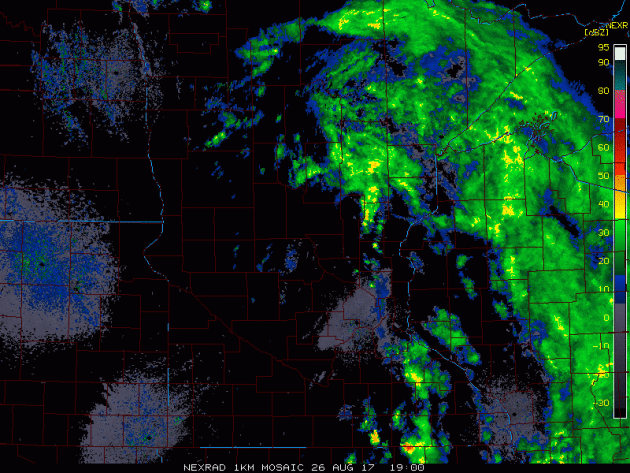Soggy Saturday at the Fair...
The Great Minnesota Get Wet Together was a bit soggy on Saturday. A steady drizzle had many dawning their flashy umbrellas and ponchos. Despite the puddley mess, the food was great, it always is. Now I can start my diet and be ready for the next pig out on Thanksgiving...
Radar Loop on Saturday
Here's the radar loop from Saturday, which showed the steadiest rains across eastern and northeastern Minnesota, while a steady drizzle fell across much of the Twin Cities metro. The rain across the metro wasn't all that heavy and it didn't add up to much, but it sure made for a damp day.

Thunder Threat Sunday and Monday
According to NOAA's SPC, there is a general thunderstorm risk across the eastern part of the state on Sunday. By Monday, the general thunderstorm risk shifts a little farther east into Wisconsin.
.png)
.png)
Simulated Radar Ahead...
Here's the simulated radar from Sunday to Monday night, which shows a few isolated showers/storms trying to develop across the region on Sunday, but by Monday, the thunder threat moves farther east into Wisconsin.

Rainfall Potential Ahead
.png)
_________________________________________________________
The rainfall forecast through PM Monday shows pockets of heavier rainfall across eastern Minnesota and into northern Wisconsin. Some locations could see up to 1" of rain or more.
.png)
_________________________________________________________
Rainfall Month To Date
It has been a pretty wet month thus far with the Twin Cities seeing 5.28" of rain through August 25th! That is nearly 2" above average for the month! Note that some locations in western Minnesota have seen nearly 7" to 10"+ of rain! So far this year, the Twin Cities has seen 24.18" of liquid precipitation, which is nearly 3" above average.
 Precipitation Year to Date
Precipitation Year to Date
Here's a look at how much precipitation we've seen so far this year. Note that precipitation amounts are quite a bit higher as you go east into Wisconsin, while precipitation amounts fall considerably as you head west into the Dakotas. La Crosse, WI has seen nearly 31.74" of precipitation this year, which is 8.56" above average! However, Fargo, ND has seen only 10.46" of precipitation this year, which is -5.05" below average, while Minot, ND has seen only 5.33" of precipitation this year, which is -7.73" below average!
.png)
While much of the state has had appreciative rainfall this month and so far this year, parts of western and northwestern Minnesota are dealing with moderate drought and abnormally dry conditions. According to the US Drought Monitor, 17.5% of the state is considered to be in a moderate drought, which is down from the 18.25% last week. Note that 3 months ago, 0.00% of the state was in a moderate drought and only 8.79% was considered to be abnormally dry.
______________________________________________________
Pollen Forecast
Itchy, sneezy? I tend to get a little more allergic to fall and I notice it more and more starting around State Fair time, which then finally starts to fade as the first frosts of the season start to arrive. With that said, according to pollen.com, the allergy forecast for Minneapolis suggests high to medium-high levels over the next few days. AHHH-CHOOO!!!
__________________________________________________________________
HARVEY Just Before Landfall on Friday
Here's a visible satellite image loop of HARVEY just before landfall on Friday night. Note how impressive the eye was, which at this point was a category 4 storm with 130mph sustained winds.

HARVEY From PM Friday to Saturday
Here's an impressive satellite loop, which shows HARVEY as a major category 4 storm from Friday night to a tropical storm as of Saturday. While the significant wind threat is over, heavy rain is still expected to be the main threat.

Widespread Damage
The reports from Rockport, TX are bleak. Significant to catastrophic damage is being reported across much of the area and the storm isn't over yet. While the strongest of winds have subsided, widespread flooding rains will continue across much of the region. Here's a story from CNN about the storm
HARVEY Tornado Threat
WOW! I'd say the NWS has been busy. This tweet was sent out Saturday afternoon, which showed all the tornado warnings that were issued across Texas since Friday. Unfortunately, additional tornadoes and flooding will be likley over the next few days.
HARVEY
Hurricane Harvey made landfall late Friday night near Port Aransas and Port O'Connor Texas as a Category 4 storm with sustained winds up to 140mph! Interestingly, this was the first category 4 storm to make landfall with the United States since Charlie in 2004. As of Saturday afternoon, HARVEY was a tropical storm with sustained winds of 65mph. While the strongest of winds is over, the catastrophic rain threat will continue through the rest of the weekend and into the week. This storm will bascially stall over the area and bring widespread heavy rainfall to many locations, some of which could see totals approaching 2ft to 3ft. !!

Here's the official track for HARVEY through the middle/end of next week, which shows stalling over Texas, which will help to prolong areas of heavy rain over the same areas over the next several days. Widespread flooding potential will continue over the next several days in these areas.